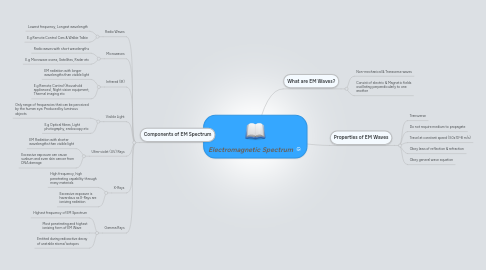
1. Properties of EM Waves
1.1. Transverse
1.2. Do not require medium to propagate
1.3. Travel at constant speed (3.0x10^8 m/s)
1.4. Obey laws of reflection & refraction
1.5. Obey general wave equation
2. What are EM Waves?
2.1. Non-mechanical & Transverse waves
2.2. Consist of electric & Magnetic fields oscillating perpendicularly to one another
3. Components of EM Spectrum
3.1. Radio Waves
3.1.1. Lowest frequency, Longest wavelength
3.1.2. E.g Remote Control Cars & Walkie Talkie
3.2. Microwaves
3.2.1. Radio waves with short wavelengths
3.2.2. E.g Microwave ovens, Satellites, Radar etc
3.3. Infrared (IR)
3.3.1. EM radiation with longer wavelengths than visible light
3.3.2. E.g Remote Control (Household appliances), Night vision equipment, Thermal imaging etc
3.4. Visible Light
3.4.1. Only range of frequencies that can be perceived by the human eye; Produced by luminous objects
3.4.2. E.g Optical fibres, Light photography, endoscopy etc
3.5. Ultra-violet (UV) Rays
3.5.1. EM Radiation with shorter wavelengths than visible light
3.5.2. Excessive exposure can cause sunburn and even skin cancer from DNA damage
3.6. X-Rays
3.6.1. High frequency, high penetrating capability through many materials
3.6.2. Excessive exposure is hazardous as X-Rays are ionizing radiation
3.7. Gamma Rays
3.7.1. Highest frequency of EM Spectrum
3.7.2. Most penetrating and highest ionizing form of EM Wave
3.7.3. Emitted during radioactive decay of unstable atoms/isotopes
